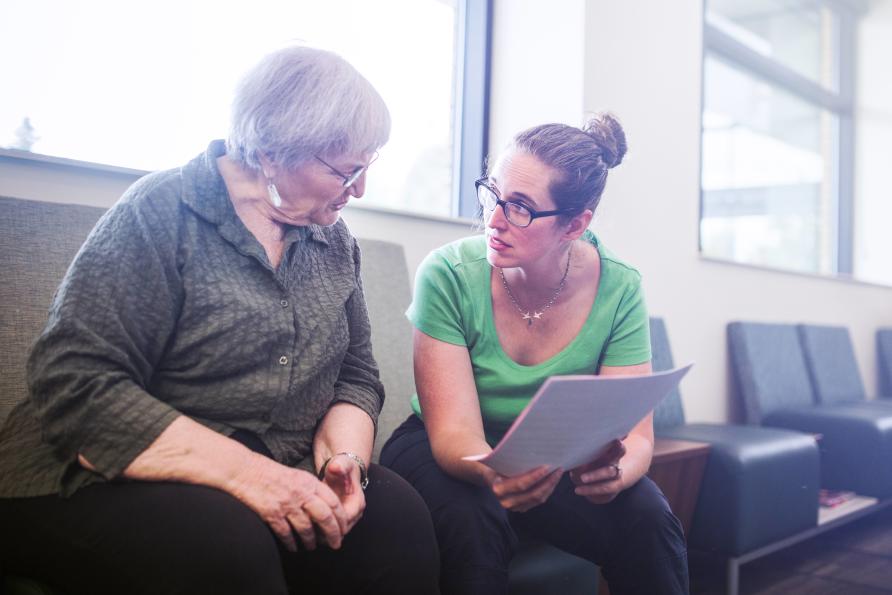A new study highlights effective ways to improving care for people living with cancer by working on the communication between physicians and their patients.
James Bonnamy was 31-years-old when he was diagnosed with colon cancer. He had a lot of questions about his diagnosis and treatment, but in the beginning, the whole process was over-whelming.
“One of the hardest things throughout my cancer journey was having to constantly make decisions when I felt I didn’t have enough information, have any real options or was ready,” he says.

And this comes back to the way physicians talk to their patients about cancer.
Effective and open communication is linked with stress reduction, improved pain control, greater understanding of and adherence to treatment, speedier recovery, and better quality of life.
But, the nature of physician-patient relationships means that they are often tied together by difficult news, especially for people living with cancer.
For both the physician and the patient, their interactions regularly involve making complex decisions while dealing with the distress caused by cancer diagnosis and treatment.
IMPROVING OUR INTERACTIONS AROUND CANCER
While there are numerous tools available to help establish good communication and support information exchange, it can be hard to know which are the most effective.
To find out, we brought together a group of researchers and clinicians from Monash University, University of Melbourne, University of Western Australia and Flinders University to investigate existing systematic reviews on communication tools, now published in CA: A Cancer Journal for Clinicians.

Our comprehensive study covered 11 systematic reviews, including 87 publications, reporting on 84 primary studies involving more than 15,000 participants.
It included communication tools that were either discussed by the physician and people with cancer or were actually used during consultations. These are tools like patient-reported outcome measures, question prompt lists, tape recordings of consultations and patient-held records.
Other tools that facilitate communication and decision-making outside of consultations were also identified, like decision aids and survivorship care plans.
We found that the use of patient reported outcomes – any report on a patient’s health that comes directly from the patient – without interpretation by a clinician or anyone else can increase satisfaction and involvement for people undergoing care. It also improves pain and symptom management, and encourages patient’s to use some of the supportive care services available.
People undergoing treatment for cancer are asked about their physical, psychosocial and mental health concerns and symptoms, and their responses result in treatments ranging from telephone counselling, hospital referrals, medication changes or the modification of chemotherapy doses.
But these patient responses vary in terms of collection and reporting, as well as who receives them and when.

TOOLS FOR CANCER COMMUNICATION
Our study takes into account a wide variety of systematically reviewed tools that have been developed to facilitate communication and support information exchange.
Electronic screening systems provide immediate feedback to physicians, while other systems include a weekly check-in, like email alerts sent to nurses if symptoms are deteriorating.
While we know that most physicians value this shared decision-making with patients, when it comes down to it, the challenges of time, high workloads and poor information systems can sometimes get in the way.
But a patient’s preferences in decision-making involvement must be taken into account.
Our research found that question prompt lists, which are structured lists of questions for the patient or their caregiver to ask their doctor, and quality-of-life questionnaires, like the European Organization for Research and Treatment of Cancer QLQ-C30, can increase the number of questions asked by patients, without increasing the length of consultations.
In fact, during his ongoing treatment for colon cancer, James found the question prompt lists very helpful.
READ MORE RELATED ARTICLES:Rethinking gastrointestinal cancer diagnosis
“The question prompt list was the best bit of information I have received as it enabled me to sit at home and think of all the questions that I wanted to ask,” he says.
Both these tools have the potential to improve information exchange and recall, while also helping to reduce a patient’s anxiety.

They may also be useful in encouraging people with cancer to consider and plan questions before their consultations, empowering them to initiate conversations that can help with issues that are important to them.
Conversely, we found limited benefits to taking audio recordings of consultations or using patient-held records as it didn’t prompt further information seeking or a better understanding during consultations.
BUT HOW WILL OUR FINDINGS EFFECTIVELY TRANSLATE INTO CLINICAL PRACTICE?
Investing in patient reported outcomes and question prompt lists, and integrating them into routine cancer care in Australia, will allow physicians to provide people living with cancer with more holistic and effective care.
Our collaborator, Professor Christobel Saunders, has already begun exploring the implementation of quality of life questionnaires into routine cancer care.
The project uses regular capture of clinical and patient-reported outcomes for five cancers (colorectal, breast, lung, prostate, and ovarian) across both public and private hospital settings in Western Australia.
Early user project feedback, from both patients and clinicians, has shown that using tools to stimulate discussion and capture patient-reported outcomes has helped to raise patient concerns that had not been previously identified or discussed. This has enabled a more full and open discussion between patient and clinician.
Increased use of communication tools also provides an opportunity for physicians to identify areas of unmet need in order to develop new care pathways and services to better support patients.

While we have strong services in pain management, which can be improved, we must ensure that we can also provide psychological support, rehabilitation, palliative care and social support.
Physicians can and should start more widely utilising question prompt lists and patient reported data.
For James, tools like this would’ve helped him to “feel more in control of my situation.”
“Not knowing what to ask at each appointment was a cause of stress with my early appointments. It would have also made me feel like I was coping better with my diagnosis”.
But, we need to understand that an increase in communication won’t translate to better care for patients unless there are health services available with the capacity to effectively respond to their needs.
We know what works and what doesn’t, so let’s use these results to improve cancer services in Australia.
“This article was first published on Pursuit. Read the original article.”





















Add Comment